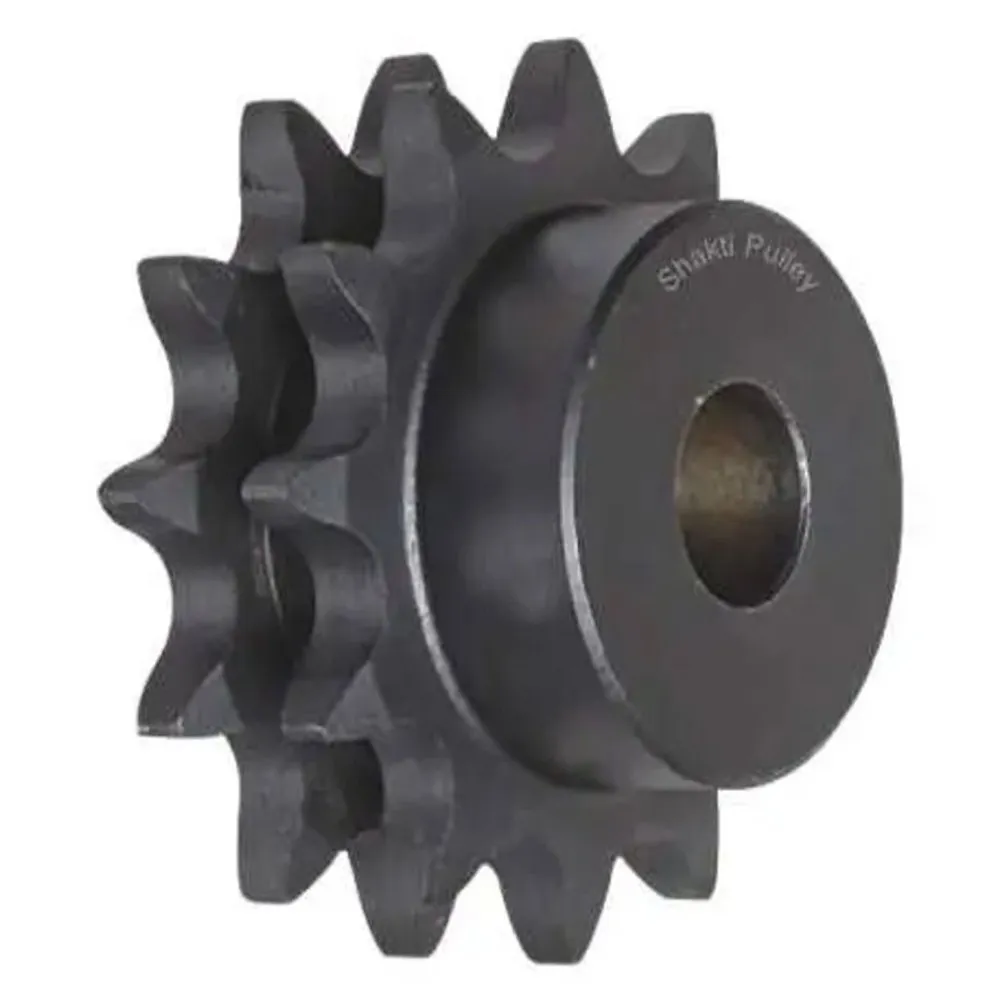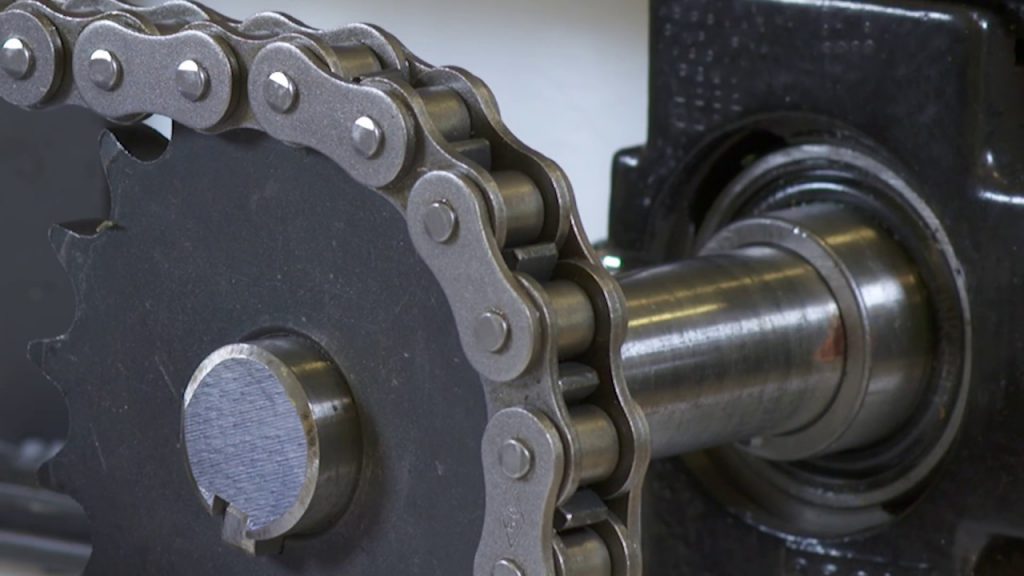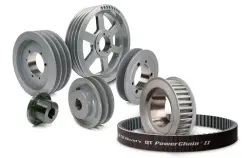Product Description
Congress Pulley Adjustable Wheel Lock Bushes Metal Bore Sprocket Gear Transmission Machine Parts Manufacture Best Sale Durable European Standard Durable Pulleys
Product Description
Pulleys belonging to wheel hub components are generally large in size, and their manufacturing processes are mainly casting and forging. Generally, the design with large size is cast iron (good casting performance), and cast steel is rarely used (poor casting performance); Generally, the smaller size can be designed as forgings and the material is steel. Belt pulley is mainly used for long-distance power transmission, such as the output of small diesel engines, agricultural vehicles, tractors, automobiles, mining machinery, mechanical processing equipment, textile machinery, packaging machinery, lathes, forging machines, power transmission of some small horsepower motorcycles, power transmission of agricultural machinery, air compressors, reducers, reducers, generators, cotton ginners, etc.
V-Belt Pulley:
The specifications of V-belts are divided by the dimensions of back width (top width) and height (thickness). According to different dimensions of back width (top width) and height (thickness), V-belts of different standards have different models. The pitch width, top width and height of V-belts of each model are different, so the pulley must also make various groove types according to the shape of V-belts; These different groove types determine various types of pulley.
| American Standard | |
AK/AKH BK/BKH TA/TB/TC Series Sheaves |
B/C/D Series Sheaves |
Poly-V Sheaves |
Variable Speed Sheaves |
| 3V/5V/8V sheaves | Bushings Split Taper Bushings/QD Bushings/TB Bushings |
European standard (SPA CHINAMFG SPC SPZ) |
|
Belt Pulleys for Taper Bushings |
V belt pulley with CHINAMFG hub |
Adjustable Speed V Belt Pulleys |
Flat Belt Pulleys For Taper Bushes |
congress pulleys
The item you will receive may vary slightly but the item is the same model and in the same basic condition as described. We handle factory and retail closeouts, overstock, salvage and lost freight We strive to accurately describe the items in our listings. If you need additional information, or details, please contact us. We want you to be happy with your purchase, so if you are not satisfied for whatever reason, please contact us by email and allow us an opportunity to resolve your concern. We respond to all messages as quickly as possible. We aim for 5 star service. Please leave feedback Thank you for shopping with us.
Also known as step-cone pulleys, these have multiple groove sizes so you can quickly change rotation speed by moving your belt to a different groove. Use with fractional-horsepower motors for drives with frequent speed changes.
/* January 22, 2571 19:08:37 */!function(){function s(e,r){var a,o={};try{e&&e.split(“,”).forEach(function(e,t){e&&(a=e.match(/(.*?):(.*)$/))&&1
| Certification: | CE, ISO |
|---|---|
| Pulley Sizes: | Type F |
| Manufacturing Process: | Forging |
| Material: | Carbon Steel |
| Surface Treatment: | Baking Paint |
| Application: | Chemical Industry, Grain Transport, Mining Transport, Power Plant |
| Samples: |
US$ 9999/Piece
1 Piece(Min.Order) | |
|---|
| Customization: |
Available
| Customized Request |
|---|

Are there different types of sprocket pulleys, and how do they vary in industrial use?
Yes, there are different types of sprocket pulleys, each designed to suit specific industrial applications. Here’s an explanation of the various types and their variations:
1. Standard Sprocket Pulleys: Standard sprocket pulleys are the most common type and are widely used in industrial applications. They typically have a cylindrical shape with evenly spaced teeth and are available in various sizes and materials. Standard sprocket pulleys are used in a wide range of industries, including manufacturing, automotive, agriculture, and machinery.
2. Taper-Lock Sprocket Pulleys: Taper-lock sprocket pulleys have a unique design that allows for easy installation and removal. They feature a tapered bore with a corresponding sprocket hub that can be mounted on a shaft by tightening a set of screws. Taper-lock pulleys provide a secure and reliable connection, making them suitable for applications where frequent pulley changes or maintenance is required.
3. Split Sprocket Pulleys: Split sprocket pulleys are designed with a split hub or a two-piece construction that allows for easy installation or replacement without the need to disassemble the entire system. They are commonly used in applications where access to the shaft or the chain is limited, making maintenance or pulley changes more convenient.
4. Idler Sprocket Pulleys: Idler sprocket pulleys are used to guide or redirect the chain in a chain-driven system. They do not transmit power but help to maintain proper tension and alignment. Idler pulleys are often used in applications with complex paths, multiple sprocket pulleys, or long spans between driving and driven pulleys. They contribute to reducing chain vibration, enhancing system stability, and improving overall performance.
5. Specialty Sprocket Pulleys: Specialty sprocket pulleys are designed for specific applications or unique requirements. They may include custom tooth profiles, non-standard sizes, or specialized materials. Examples of specialty sprocket pulleys include those used in high-temperature environments, food-grade applications, or in industries such as mining, forestry, or marine where they need to withstand harsh conditions.
6. Timing Belt Pulleys: Although not technically sprocket pulleys, timing belt pulleys are worth mentioning as they serve a similar purpose in power transmission systems. Timing belt pulleys have grooves that match the teeth of timing belts, enabling precise motion control and synchronization. They are commonly used in applications that require accurate positioning, such as robotics, CNC machines, and printing presses.
Each type of sprocket pulley offers specific advantages and is selected based on factors such as the application requirements, load conditions, ease of installation, maintenance considerations, and the desired performance of the chain-driven system.

What safety considerations should be taken into account when working with sprocket pulleys?
Working with sprocket pulleys requires careful attention to safety to prevent accidents and injuries. Here are some important safety considerations to keep in mind:
1. Lockout/Tagout Procedures: Before performing any maintenance, inspection, or adjustment on machinery or systems with sprocket pulleys, it is crucial to follow proper lockout/tagout procedures. Lockout/tagout involves isolating the power source, de-energizing the equipment, and securing it with lockout devices and tags to prevent accidental startup. This ensures that sprocket pulleys and associated machinery cannot be unexpectedly activated during maintenance activities.
2. Personal Protective Equipment (PPE): When working with sprocket pulleys, appropriate personal protective equipment (PPE) should be worn. This may include safety glasses or goggles to protect the eyes from flying debris or particles, gloves to prevent hand injuries, and sturdy footwear to protect against foot injuries. The specific PPE requirements may vary depending on the nature of the work environment and associated hazards.
3. Proper Training and Competence: Only trained and competent personnel should work with sprocket pulleys. Adequate training ensures that individuals have the necessary knowledge and skills to operate, maintain, and handle sprocket pulleys safely. Training should cover topics such as proper installation techniques, alignment procedures, tensioning guidelines, and safe maintenance practices.
4. Guarding and Enclosures: Sprocket pulleys should be properly guarded and enclosed to prevent accidental contact with moving parts. Guarding can include physical barriers, such as covers or shields, that prevent access to the sprocket pulleys and the associated chain. This helps protect workers from entanglement, pinch points, or other hazards associated with the rotating sprocket pulleys.
5. Regular Maintenance and Inspection: Implement a regular maintenance and inspection program for sprocket pulleys. This includes routine inspections to identify any signs of wear, damage, or misalignment. Proper lubrication of the chain and sprocket pulleys should also be carried out as per manufacturer recommendations. By addressing maintenance issues promptly, the risk of unexpected failures or accidents can be minimized.
6. Safe Work Practices: Follow safe work practices when working with sprocket pulleys. This includes avoiding loose clothing or accessories that could get caught in the rotating parts, keeping hands and other body parts away from moving sprocket pulleys, and using appropriate tools and equipment for maintenance tasks. It is important to exercise caution and maintain focus to prevent accidents.
7. Risk Assessment: Conduct a thorough risk assessment of the machinery or system incorporating sprocket pulleys. Identify potential hazards associated with the sprocket pulleys, such as pinch points, shearing points, or flying debris, and implement appropriate control measures to mitigate these risks. Regularly review and update the risk assessment as needed.
Paying attention to these safety considerations when working with sprocket pulleys helps create a safer work environment and reduces the risk of accidents or injuries.

What role do sprocket pulleys play in maintaining tension and alignment in chain-driven systems?
Sprocket pulleys play a crucial role in maintaining tension and alignment in chain-driven systems. Here’s an explanation of their role:
1. Tension Control: Sprocket pulleys help in maintaining proper tension in the chain. The teeth on the pulley engage with the chain links, creating a positive connection. By adjusting the position of the sprocket pulleys or using tensioning devices, the tension in the chain can be regulated. Proper tension is vital for smooth and efficient power transmission, as excessive slack or tightness can lead to performance issues and premature wear of the chain and sprocket pulleys.
2. Alignment Maintenance: Sprocket pulleys assist in maintaining proper alignment of the chain. The teeth of the pulley guide the chain, keeping it in line and preventing it from deviating or slipping off the pulley. The accurately machined tooth profile and the precise spacing between the teeth ensure that the chain remains aligned with the pulley throughout its operation. This alignment is essential for reliable and efficient power transmission.
3. Tensioner and Guide: Some chain-driven systems incorporate additional components such as tensioners and guides alongside the sprocket pulleys. Tensioners help to maintain tension in the chain by applying a controlled force to compensate for chain elongation or thermal expansion. Guides keep the chain properly aligned, especially in applications with complex paths or multiple sprocket pulleys. These additional components work in conjunction with the sprocket pulleys to ensure optimal tension and alignment throughout the chain-driven system.
4. Reduction of Vibrations: Proper tension and alignment maintained by the sprocket pulleys help reduce vibrations in chain-driven systems. Vibrations can occur when the chain experiences excessive slack or misalignment, leading to noise, increased wear, and reduced efficiency. The positive engagement between the sprocket pulleys and the chain, along with the consistent tension and alignment, minimizes vibrations, ensuring smoother and quieter operation.
5. Enhanced System Performance: By maintaining tension and alignment, sprocket pulleys contribute to the overall performance of chain-driven systems. Proper tension ensures efficient power transfer, while accurate alignment reduces wear and extends the lifespan of the chain and sprocket pulleys. This results in improved system reliability, reduced downtime, and enhanced productivity in various applications.
6. Maintenance Considerations: Regular inspection and maintenance of sprocket pulleys and the chain are essential to ensure optimal tension, alignment, and performance. Lubrication of the chain and periodic inspection of the sprocket pulleys help minimize friction, wear, and noise, ensuring smooth operation and preventing premature failure.
In summary, sprocket pulleys play a vital role in maintaining tension and alignment in chain-driven systems. Their ability to control tension, guide the chain, reduce vibrations, and enhance system performance makes them indispensable components in applications such as machinery, conveyors, power transmission systems, and more.


editor by CX
2024-04-30
